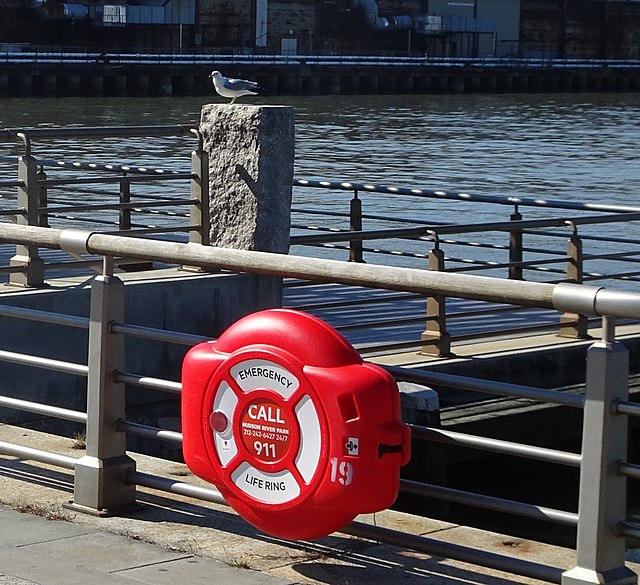For over 20 years, the utility giant Con Ed (Consolidated Edison) has dumped millions of gallons of wastewater from below Manhattan’s Pier 98 straight into the Hudson River. The Hudson River Park Trust, a group created to protect and preserve that portion of the Hudson River and its estuarine sanctuary, has been renting the pier to Con Ed for over $1 million a year, according to a piece by the New York Times.
River water is gathered to fill and flush giant boilers and cool high-voltage electrical cables at the local Con Ed plant, then dumped back into the river. The dumped wastewater ranges from 90 degrees Fahrenheit and up, often containing toxic elements such as chromium, chloroform, and lead.
Pier 98, at the edge of Hell’s Kitchen, is officially within the bounds of the Hudson River Estuarine Sanctuary. Created in 1998, the sanctuary protects 400 acres of in-water area and provides a critical habitat for over 70 species of fish and birds.
The discovery was made public by Tom Fox, board member to the trust and leading member in the creation of the Hudson River Park. Fox had noticed a series of pipes snaking along Pier 98 and began to investigate their purpose, unlocking a moral paradox that he and the other board members of the park were not aware of.
“The trust is getting paid rent to allow the pollution of the estuary they were established to protect,” said Mr. Fox. Backed by City Club, Tom Fox is currently working on suing Con Ed and the New York City Department of Environmental Conservation (DEC) for violations of the federal Clean Water Act. He also seeks an injunction to stop current and future wastewater dumping.
“Con Ed’s continued thermal and industrial discharge into the sanctuary – facilitated by the defiance of federal and state laws enforced by DEC and the Trust – represents a threat to the conservation and protection of those resources,” the notice said. Advocates say Con Ed should not be allowed to continue remaining and operating within the park.
While officials of the trust knew of the dumping, the appointed members of the trust’s council of advisers did not and were never told about the park’s agreement to rent a pier to Con Ed for this purpose.
“Nobody knew about it. I didn’t know about it, and I’ve been associated with Park for 40 years, from the very beginning,” said Fox in a recent interview with ABC news, “I think for whatever reason, it was not publicly acknowledged. Now that it is, we have a chance to fix the situation.”
Heated Waters Leads to Dead Fish
Con Ed denies many of the allegations brought forth by City Club. A spokesperson for Con Ed reported wastewater dumping occurred twice a week and said toxic elements within the released water were “minimal.”
Utility wastewaters generally undergo treatment in wastewater treatment plants, where testing, treatment, and remediation protect the environment from pollutants gathered within the water. It is still unclear to what affect dumping has affected the Hudson River specifically, but plumes of hot water are dangerous to marine life.
Heated waters decrease the levels of dissolved oxygen, suffocating aquatic creatures and throwing off the migratory patterns of local fish and wildlife. The Estuarine Sanctuary also serves as a corridor for birds and other wildlife, indicating damage could reach beyond marine life.
Among other concerns, advocates worry for locals who eat fish caught from the pier. Over the years, large groups of dead fish have mysteriously appeared along the Hudson. These fish, called Atlantic Menhaden (or bunkers) swim in large schools and are vulnerable to low levels of oxygen and pathogens. The DEC claims the dead Menhaden were caused by overcrowding and the warming of the water but claimed to not know the source of the problem.
Con Ed Uses Pier 98 for Decades
Con Ed has a long history with Pier 98, but use of the space has changed dramatically over time. As New York’s largest utility company, Con Ed distributes electricity, natural gas and steam throughout the city and began operating on Pier 98 in 1959, originally docking oil barges there.
Once the Hudson River Park was established in 1998, the utility company was grandfathered in, some claim out of necessity. Con Ed relies on Pier 98 for the millions of gallons of river water that it uses to cool cables in a substation on West 49th Street. When in use, Con Ed pumps more than four million gallons a day from the Hudson.
In 2006 Con Ed requested permission from the DEC to allow the dumping of higher temperature waters, up to 104 degrees. The standard limit for dumping heated water into protected estuaries is 90 degrees Fahrenheit. After conducting a public hearing, permission was granted by the DEC in 2011. While a public notice was published by the trust in the City Register, the notice contained no mention of “water cooling” and did not indicate what exactly was being approved. The approval also violated standards set by the federal Clean Water Act.
This is not the first time the city has negotiated with Con Ed on wastewater dumping. In 2010 Con Ed paid $5 million in fines for wastewater violations in compliance with a consent order presented by the DEC. In the final order Con Ed agreed to pay $1 million in fines, while the remaining $4 million was set aside to build an education center for the Hudson River Park. Yet this center, called the Estuarium, was never constructed. Trust officials claim The Estuarium is still in the planning stages.
Following 2010, department records indicate 21 known violations of wastewater standards and monitoring requirements. Both Con Edison and the DEC dispute these allegations.
Effects on the Ecosystem and New York City Housing
Damage to the Hudson River has been a long-standing problem for New York, dating back to the 1970s. Previously, General Electric (GE) was found guilty of polluting the Hudson River with mercury and untreated sewage, creating major environmental damage. Activists protested in a variety of ways; musician Pete Seeger created the Hudson River Sloop Clearwater and the Clearwater Festival to garner attention to the problem. Eventually, nationwide activism led to the federal Clear Water Act, created in 1972, followed by the Toxic Substances Control Act of 1976. The federal government then designated the 200-mile contaminated portion of the river as a Superfund site in 1984.
Water pollution does more than just harm the ecosystem; it also damages property values for surrounding businesses and housing. Studies have shown effective abatement of polluted waterways leads to major increases in the value of single-family homes situated on the waterfront. Lot values increase by 8 to 25%, and property values can be affected up to 4,000 feet away from the water’s edge. Previously polluted waterfronts that have received protection and been allowed to recover have been major contributors to real estate growth.
More recently, the city has been busy implementing other projects meant to protect and bolster aquatic life within the Hudson River. In 2021, 11.2 million juvenile oysters were added to New York Harbor by the Tribeca Habitat Enhancement Project. Acting as nonstop water filters, oysters are a solution to rehabilitating the polluted waterways surrounding the city. While New York was once famous for its oysters, these cannot be eaten. The water is still too polluted for safe consumption.
Residents now wonder about the safety of swimming or fishing in the Hudson River, but it will be a while until testing and results indicate to what extent the damage has done. Still, a legal battle between Con Ed and City Club could lead to an increase in protections for the Hudson River.
Lindsey Rae is a freelance writer, videographer, and medium format photographer with a background in economics, documentary filmmaking, and human rights. In past lives she covered the arts scene in Seattle and LA before morphing into a finance journalist, reporting from the NYSE for German news media. When not writing about culture & lifestyle she can be found studying herbalism and traditional healing techniques. She enjoys running, yoga, and world travel. You can find her at www.linerae.com or IG @hunteressthompson



